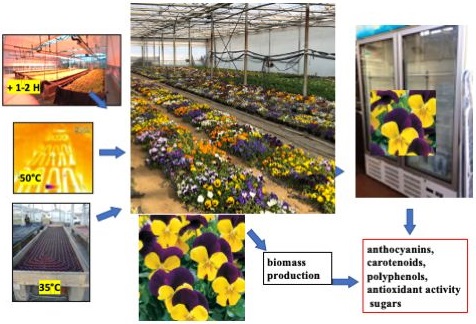Different growing conditions can modulate metabolites content during post-harvest of Viola cornuta L. edible flowers

Published 2020-05-13
Keywords
- cold storage,
- greenhouse cultivation,
- horned pansy,
- secondary metabolites
How to Cite
Funding data
-
Interreg
Grant numbers ALCOTRA V-A France-Italy ANTEA Project n.1139 – Attività innovative per lo sviluppo della filiera del fiore edule/ Fleurs comestibles: innovations pour le development d’une filière transfrontalière.
Abstract
Edible flowers are inflorescences traditionally used in various part of the world to enrich sweet and savoury recipes. The flowers of Viola spp. were appreciated since the Romans, and today the fresh products are now incorporated as ingredients in different culinary preparations. In this work, cultivation of potted Viola cornuta L. cv. Penny Lane was performed in greenhouse with different environmental conditions (basal heating, additional LED lighting and moisture management) and therefore the biomass production (number of flowers per square meter and plant dimension per pot) was assessed. The plants are characterised by flowers with dark purple and orange petals in the same corolla. The shelf-life of detached flowers was studied in post-harvest conditions at 0 and 4 days of cold storage at 4°C (polyethylene boxes, 12/12 h light/dark condition) to simulate the condition of I gamma products. Sugars and secondary metabolites were analysed. Basal heating seems not to increase flower number but could contribute to reach a well-balanced simultaneous presence of different antioxidant molecules (polyphenols, anthocyanins, carotenoids). Our data highlight that the short cold storage under light condition lead to an increase in the content of total polyphenols and antioxidant activity, although a general reduction in pigments and sugars is observed.






